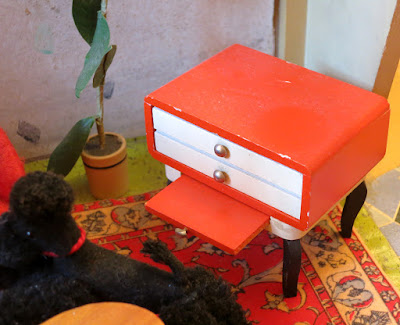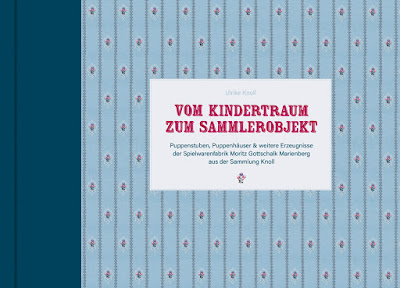Die Detailfotos zeigen die aufwändige Holzverarbeitung der Miniaturmöbel.
Note the excellent craftmanship in wooden miniatures.
1954
Wohnzimmermöbel - Ende der 50er Jahre
Dagmar's Collection
TV und Radio mit Schiebetür
- entweder TV...
TV and radio with a sliding door - either TV ...

...oder Radio.
...or radio.
Edmund Müller -
Erzgebirgische Kleinkunst- Holz- und Spielwarenfabrik -
Seiffen, Erzgebirge
Die
Erben des Gründers haben eine informative Webseite
zusammengestellt,
die ausführlich und mit vielen historischen Fotos über
die Familiengeschichte berichtet.
Puppenstubenmöbel stellten das Hauptsortiment zwischen 1915 und 1956.
"Im
Mittelpunkt der obiger Abbildungen ist das Gesellenstück
von Gunter
Müller aus dem Jahr 1950.
Darin kann man sehr gut die äußerst aufwändige
Verpackung erkennen.
Jedes Teil einer Puppenstube wurde mit Strick im
Pappkarton an der richtigen Stelle angeordnet.
So verpackte Möbel
überstanden nicht nur lange Transportwege,
sondern waren auch
repräsentativ in jedem Geschäft.
Dolls' house furniture was the main focus of the product line
Zudem wurden alle Polstermöbel für die Puppenstuben per Hand gepolstert und vernäht.
Die
dokumentierte Firmengeschichte seit 1899 erklärt auch
viele meiner
Fragen zum Überleben eines kleinen Unternehmens zu Zeiten der Kriege,
der Weltwirtschaftskrise oder der Planwirtschaft in der DDR.
Zum Beispiel erfährt man,
Zum Beispiel erfährt man,
warum ab 1959 kein Spielzeug
und nur noch
kunstgewerbliche Artikel hergestellt wurden.
Ganz interessant zur
Datierung der oben gezeigten Puppenmöbel übrigens!
"The journeyman's piece
of Gunter Müller from 1950.
The extensive packaging can clearly be seen.
Each piece of a doll's room was arranged at its right place and fixed
by string.
These furniture packages survived long transport and were
representable in every shop.
All upholstered furniture were fabricated manually." (Website)
The documented history since 1899 answers many of my questions
concerning
the survival of a company in times of war,
depression and state-directed
economy,
e.g. why from 1959 on they did not produce any more dolls
furniture
but only arts and crafts products.
Quite interesting for
dating the furniture shown above!
Jedes
Möbel passte auch perfekt in seine Zeit.
So sieht man auf obigen
Abbildungen ganz deutlich,
welches Möbel z.B. in die 50-iger Jahre
gehört
und zu DDR Zeiten entstanden ist.
So gab es u.a. auch eine
Lizenzvereinbarung mit dem Staatsfernsehen
zum Nutzen von
Sandmannmotiven für die Fernsehmöbel.
Each
piece of furniture represented perfectly the interior design style of
its time.
There even was a licence agreement with the state television
about the use of the famous sandman on the dolls TV set.
(Text der Webseite)
Auszüge aus der Geschichte der Firma, die die DDR-Zeit betreffen:
Extracts from the history relating to the GDR:
"1956
Nach 30 Jahren der vorerst letzter Besuch des Unternehmens auf der Leipziger Messe. Aus politischen Gründen ist es privaten Firmen nicht mehr möglich, unmittelbar Kontakt zu ihrem weltweiten Kundenstamm zu halten. Staatliche Betriebe wie DHZ und DEMUSA übernehmen jetzt den Absatz der Produkte."
After 30 years the last appearance on the fair in Leipzig for the time being. Political reasons prevent that private firms keep contact to their foreign customers. State enterprises like DHZ and DEMUSA take over the marketing.
"1960
Durch die zentrale Materialbeschaffung in der DDR sind die benötigten Roh- und Hilfstoffe immer schwieriger zu beschaffen."
Because of the central acquisition of material in the GDR the needed raw materials and intermediates are more and more difficult to obtain"
"1962
Nachdem die Puppenmöbelproduktion als Spielwarenindustrie eingestuft wird und deren Herstellung keinen Ertrag mehr bringt, kommt diese völlig zum Erliegen."
Dolls furniture is classified as toy industry and that production does not yield any more, it comes to a complete standstill.
"1986
Durch die Lohnklausel zwischen staatlichen Betrieben und privaten Handwerkern schrumpft die Mitarbeiterzahl auf drei Personen."
By the wage clause between state enterprises and private artisans the number of employees shrinks to three.
Ein toller Internetauftritt und eine schöne Wahrung der Tradition einer Firma und Familie.
A great website and a beautiful preservation of tradition of a company and a family.

Kleinmöbel in Rot
Alle gezeigten Möbel sind aus den Fünfziger Jahren.
All shown furniture is from the Fifties.
Sammlung Bruchsal

Kleinmöbel in Rot
Alle gezeigten Möbel sind aus den Fünfziger Jahren.
All shown furniture is from the Fifties.
Nicely illustrated report in English about >"Toymakers of the Erzgebirge" -
on page 16 (bottom) to 18 Ringo Müller, the great-grandson of Edmund Müller, is interviewed.
on page 16 (bottom) to 18 Ringo Müller, the great-grandson of Edmund Müller, is interviewed.
Der Blogbeitrag ist von mir stark gekürzt worden, im März 2024,
da Google Fotos viele meiner alten Fotos
als nicht gesichert eingestuft hatte und sie deshalb nicht mehr anzeigte.
Wenn nicht anders vermerkt, sind alle Fotos aus meiner Sammlung
 diePuppenstubensammlerin
diePuppenstubensammlerin
Dieses Werk ist lizenziert unter einer Creative Commons Namensnennung - Nicht kommerziell - Keine Bearbeitungen 4.0 International Lizenz.
 diePuppenstubensammlerin
diePuppenstubensammlerinDieses Werk ist lizenziert unter einer Creative Commons Namensnennung - Nicht kommerziell - Keine Bearbeitungen 4.0 International Lizenz.







.JPG)















.JPG)





.jpg)





















